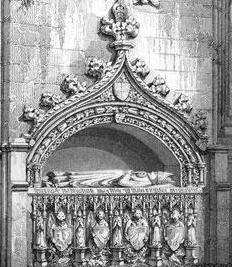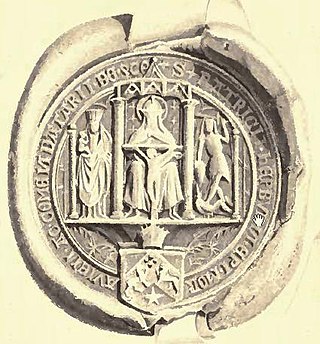Related Research Articles
Roger de Beaumont was a 12th and 13th century Bishop of St Andrews.
Gilbert de Moravia, later known as Saint Gilbert of Dornoch, or Gilbert of Caithness, was the most famous Bishop of Caithness and founder of Dornoch Cathedral. His name may suggest that he came from the semi-Gaelicized family of Flemish origin who were Lords of Duffus, and who during Gilbert's episcopate would create the Earldom of Sutherland under Gilbert's possible cousin, William de Moravia, 1st Earl of Sutherland.

Bricius was prior of Lesmahagow and afterward bishop of Moray.
Andreas de Moravia was a 13th-century Scottish bishop. He was a younger son of Hugh de Moravia, from the family of Flemish origin who were lords of Duffus and other areas in the Greater Moray region in this period. In the time of Bishop Bricius' episcopate (1203–1222), there was a man called "Andreas" who was rector of the church of St. Peter at Duffus, and this may well have been this Andreas. He may also have been a native Scot.
William de Bondington was a 13th-century Chancellor of Scotland and a bishop of Glasgow.

Robert de Cardeny was a late 14th and early 15th century Scottish cleric. He was the son of one John Cardeny, and brother of the royal mistress Mariota de Cardeny. His early career is obscure. In 1378–80, King Robert II of Scotland petitioned the Pope for a canonry in the diocese of Moray for one Robert de Cardun, despite the fact that the latter already held canonries and prebends in the diocese of Dunblane and Dunkeld. This Robert de Cardun was both a member of King Robert's household and a student at the University of Paris. Robert had graduated from Paris in 1381 as Licentiate. In 1392 he was a receiver of the "English Nation" at Paris and custodian of the Nation's seal. In 1394 Robert was still in Paris, now as Master Robert de Cardeny

Henry de Lichton [de Lychtone, Leighton] was a medieval Scottish prelate and diplomat, who, serving as Bishop of Moray (1414–1422) and Bishop of Aberdeen (1422–1440), became a significant patron of the church, a cathedral builder, and a writer. He also served King James I of Scotland as a diplomat in England, France, and Italy.

Columba de Dunbar was Bishop of Moray from 1422 until his death at Spynie Palace near Elgin sometime before 7 November 1435.
The Diocese of Moray was one of the most important of the medieval dioceses of the Roman Catholic Church in Scotland. Its territory was in central northern Scotland.
Simon de Tosny was a 12th-century Cistercian monk and prelate. Simon was a monk of Melrose Abbey, and served there until he moved to become Abbot of Coggeshall Abbey in Essex. He resigned this abbey in 1168, and returned to Melrose. In 1171, he was elected as Bishop of Moray, and was consecrated at St Andrews on 23 January 1172. He was a distant cousin of King William who may or may not have played some part in his election. His cathedral was at Birnie, Moray. He witnessed several charters and was present at the Council of Northampton in 1176. He is the first bishop named on the bishop-list in the Moray Registrum. He died on 17 September 1184 and was buried in Birnie Kirk. Aside from the brief episcopate of Andrew he was succeeded as bishop by Richard de Lincoln.
John de Pilmuir [Pilmor, Pylmore] was a 14th-century prelate based in Scotland. He was probably the son of Adam de Pilmuir, a Dundee burgess, and the brother of Richard de Pilmuir, Bishop of Dunkeld (1337/38–1345/47).

Andrew Stewart was a 15th-century Scottish prelate and administrator.

Patrick Hepburn was a 16th-century Scottish prelate. He served as both pre- and post-Reformation Bishop of Moray.

The Diocese of Ross was an ecclesiastical territory or diocese in the Highland region of Scotland during the Middle Ages and Early modern period. The Diocese was led by the Bishop of Ross, and the cathedral was, latterly, at Fortrose. The bishops of the Early Church were located at Rosemarkie. The diocese had only one Archdeacon, the Archdeacon of Ross, first attested in 1223 with the appearance of Archdeacon Robert, who was consecrated bishop of Ross on 21 June 1249 x 20 June 1250. There is only one known Dean of Christianty (sic), one Donald Reid called the dean of christianty of Dingwall on 12 June 1530.
Robert de Fyvie [also de Fyvin] was a prelate based in the Kingdom of Scotland in the last quarter of the 13th century. Perhaps coming from Fyvie in Formartine, from a family of Teesdale origin, Robert was Archdeacon of Ross and a student at the University of Bologna by 1269. In 1275, he was not only a graduate but the new Bishop of Ross, a post he held until his death in the first half of the 1290s.
Alexander de Kylwos – written alternatively as Frylquhous, Kylquos, and a variety of other forms – was a Scottish churchman and prelate active in the second half of the 14th century. He is known to have held senior positions in three bishoprics, and senior offices in two, before being elected and appointed Bishop of Ross in 1371. Though his episcopate is relatively obscure, he seems to have spent almost all of it inside or around his province, was closely associated with William III and Euphemia I, successive rulers of Ross, and was an associate of the famous Alexander Bur, Bishop of Moray, during the latter's struggle with Alexander Stewart, the son of the King later known by the nickname "Wolf of Badenoch".

Albin was a 13th-century prelate of the Kingdom of Scotland. A university graduate, Albin is known for his ecclesiastical career in the diocese of Brechin, centred on Angus in east-central Scotland.
Laurence de Ergadia was a thirteenth-century Scottish bishop. Probably from the MacDougall kindred of Argyll, Laurence had become a Dominican friar and presumably university graduate before being elected Bishop of Argyll, an election which took place sometime between 1262 and 1264. Although the election was quashed by the Pope in 1264, the Pope gave him a fresh provision to the bishopric. Laurence appears intermittently in the records during his three and a half decade episcopate, but his activities in his own diocese are badly recorded. He died as Bishop of Argyll sometime in either 1299 or 1300.
Walter de Coventre was a 14th-century Scottish ecclesiastic. There is no direct evidence of his birthdate, his family, or his family's origin, although he may have come from the region around Abernethy, where a family with the name de Coventre is known to have lived. Walter appeared in the records for the first time in the 1330s, as a student at the University of Paris. From there he went on to the University of Orléans, initially as a student before becoming a lecturer there. He studied the arts, civil law and canon law, and was awarded many university degrees, including two doctorates. His studies were paid for, at least partially, by his benefices in Scotland. Despite holding perhaps more than five benefices at one stage, he did not return to Scotland until the late 1350s.

Gregor MacGregor was Bishop of Moray, Ross and Caithness in the second half of the 20th century.
References
- Dowden, John, The Bishops of Scotland, ed. J. Maitland Thomson, (Glasgow, 1912)
- Fawcett, Richard & Oram, Richard, Elgin Cathedral and the Diocese of Moray, Historic Scotland (Edinburgh, 2014), ISBN 978-1-84917-173-1
- Keith, Robert, An Historical Catalogue of the Scottish Bishops: Down to the Year 1688, (London, 1924)
- Watt, D.E.R., Fasti Ecclesiae Scotinanae Medii Aevi ad annum 1638, 2nd Draft, (St Andrews, 1969)